Tick Pictures (copyright © Marc Golightly, Ph.D.) | |
A. Deer Tick Larva | Larva at high power - note six legs as opposed to eight for
nymph and adults. Larva rarely carry Lyme disease
organisms and it would be EXTREMELY rare to get Lyme disease from the bite of a deer tick larva | |
B. Deer Tick Nymphs - unengorged (left), engorged (right)
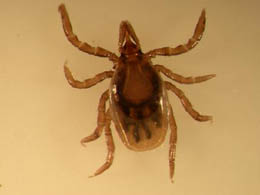
 | |
| Note the long mouth parts vs short mouth parts on the Dog tick. Nymphs are small and can carry the Lyme disease organism. The back plate (scutum) is dark solid brown as opposed to the dog tick (see below) | |
C. Dog Ticks (Dermacentor variabilis)Adult Female
 
| |
| Dog ticks do not carry Lyme disease. They are easily identified by the creamy (tan) colored lines and color on the back plate (scutum) | |
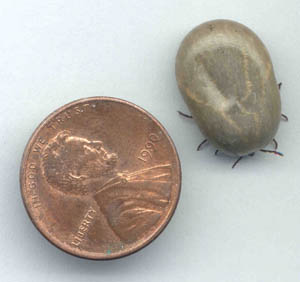 Fully engorged female dog tick - this picture does not show scutum (it is there, just running perpendicular to the plane of the penny - see picture below). | |

Same tick as above, but oriented to see scutum | |
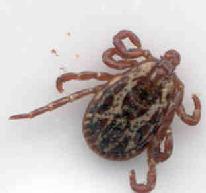 Adult Male Adult Male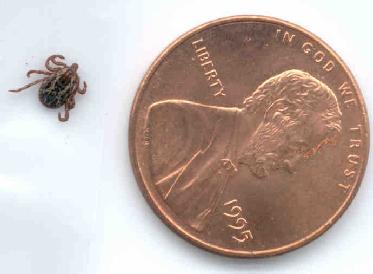 | |
 D. Fully Engorged Lone Star Ticks (Amblyomma americanum) | |
| The white dot on the scutum is evident and identifies this tick as a loneStar tick, which can also carry Lyme disease organism, but according to the CDC and NY State Health Dept is thought not to transmit the disease to humans. Also note the long mouth parts. In all engorged ticks the scutum does not expand and is a good place to start for identification. | |
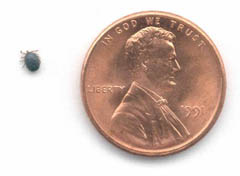 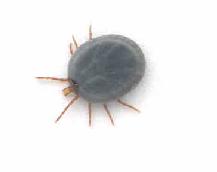 | |
 Borrelia Picture (courtesy of Dr Jeff Nelson) Borrelia Picture (courtesy of Dr Jeff Nelson) Borrelia burgdorferi growing in culture. Clumping of spirochetes is thought to be an affinity of the organisms for close contact or to control their microenviroment | |
| | |
| | |
| | |
Visit our other
Immunology Laboratories | Services |
| Immunology Laboratories home page | Home page, general information |
| Laboratory for the Diagnosis of Tick Borne Diseases | Lyme Disease, Babesiosis, Ehrhlichiosis |
| Main Immunology Laboratory | Immunochemistries, Autoimmune (ANA, ANCAs, Anti-Cardiolipin, anti-DNA, ENA, etc) & bacterial and viral Serologies |
| Clinical Flow Cytometry Laboratory | Immunophenotyping Leukemias/Lymphomas, T cellSubsets, DNA analysis, Stem Cell quantitation, PNH determinations |
| Research Flow Cytometry Core Facility | Research consultation, Cell sorting & Analysis, Instructional classes, Fee Schedules and Scheduling time via internet |
Contact Information for Laboratory for the Diagnosis of Tick Borne Diseases:
Technical Service (631) 444-7965
Laboratory (631) 444-3824
Mel Evans, B.S., MT (ASCP), Section Supervisor (631) 444-2195
Kenneth O'Sullivan, M.S., MT (ASCP) Supervisor/Associate Technical Director (631) 444-2373
Marc Golightly, Ph.D., SI(ASCP) Director/Head (631) 444-2240
mgolightly@notes.cc.sunysb.edu
This page maintained and updated by Marc Golightly,Ph.D. Last updated May 22, 2007
 Visit my home page
Visit my home page
![]() Visit my home page
Visit my home page 







 Adult Male
Adult Male



